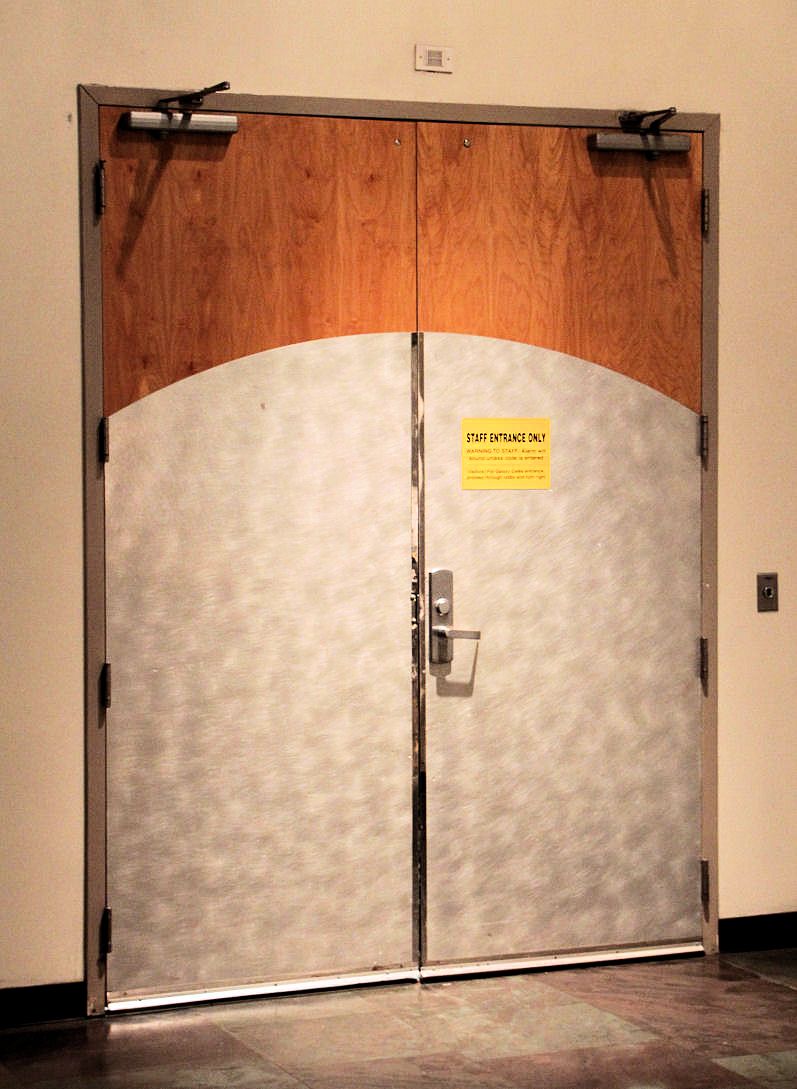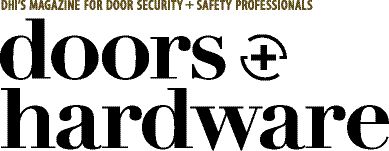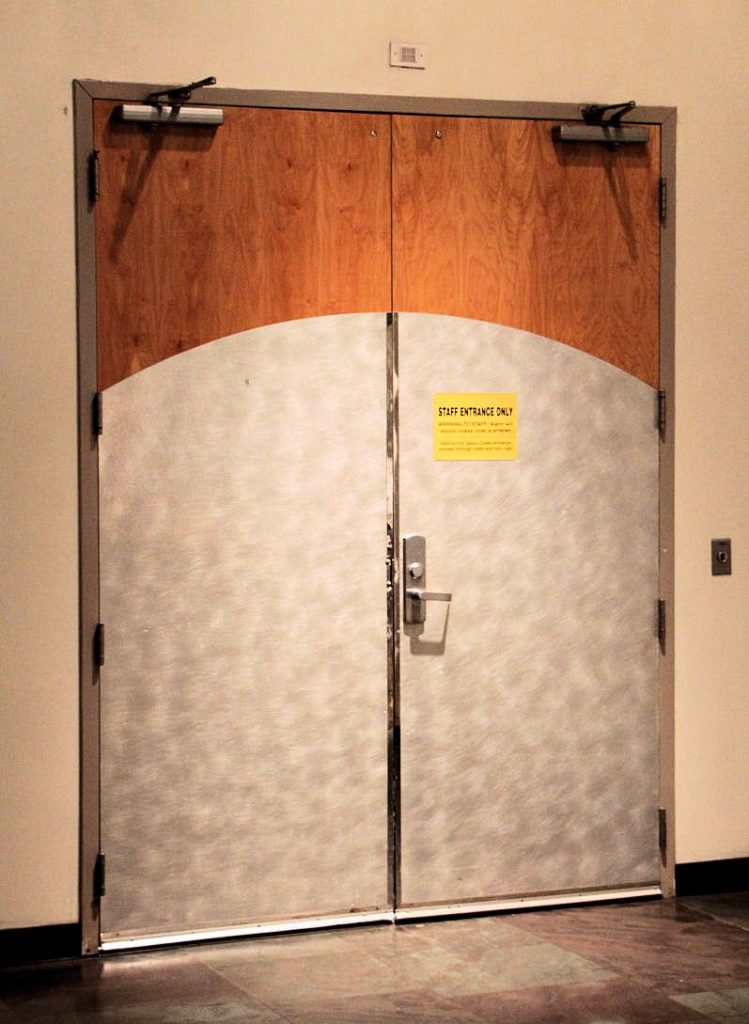This post was published in D.lllloors & Hardware
For such a simple piece of hardware, protection plates installed on fire doors have caused more than their fair share of trouble, particularly in health care facilities. Several editions of NFPA 80 – Standard for Fire Doors and Other Opening Protectives, have included varying requirements for field-installed and factory-installed plates, and a change was made to the 2016 edition of the standard that impacts these requirements going forward.
A protection plate may be a kick plate, mop plate, stretcher plate, or armor plate, installed to protect the face of the door from damage due to traffic and abuse. NFPA 80 defines a door protection plate as “protective material applied to the face of a door and generally made of approximately 0.05 in. (1.2 mm) thick brass, bronze, aluminum, or stainless steel or 1∕8 in. (3.2 mm) thick laminated plastic.” Protection plates are one of the types of surface-mounted hardware that is allowed by NFPA 80 to be installed as a job-site preparation, since installation with screws only requires small holes in the face of the door.
Most of the questions and problems regarding protection plates are related to the labels that are required for some plates, depending on their location on the door. Plates that are mounted within the bottom 16 inches of the door height are not required to bear a label stating that they are listed for use on a fire door assembly. Most kick plates are mounted within this portion of the door and do not require a label.
Armor plates typically extend above the 16-inch mark, and stretcher plates are mounted in the location where a hospital stretcher, gurney, or bed would contact the door. Prior to the 2016 edition, NFPA 80 required these plates to be labeled and installed in accordance with their listing when the plates were installed in the field. If plates were factory-installed (including plates installed under label service in a distributor’s shop), the plates were not required to be labeled as long as they were installed in accordance with the listing of the fire door.
The problem with installing non-labeled plates in the factory or shop is that once the doors arrive in the field with factory-installed plates extending above 16 inches, there is no way for a fire door assembly inspector or Authority Having Jurisdiction (AHJ) to know whether the plate was field-installed and is missing the required label, or was factory-installed and does not need a label. Because of this, non-labeled plates on fire doors have often been replaced with labeled plates in the field. Existing plates may also be inspected by a listing laboratory and labeled in the field if found to be compliant, but both of these solutions can be costly.
All recent editions of NFPA 80 allow non-labeled plates mounted within 16 inches above the bottom of the door, but plates that are mounted or extend above the 16-inch mark are required to be labeled. Beginning with the 2016 edition, the label requirement applies to both factory-installed plates and plates that are field-installed. In both cases, the plates must be in accordance with the listings of the door manufacturer. For example, a door manufacturer’s listings may allow a plate up to 48 inches high, on one or both sides of the door. The listings may also specify the type of material that is allowed, and may require a certain type of fasteners or adhesive to be used. In some cases, the door manufacturer’s listings may allow either labeled or non-labeled plates to be installed, but in order to comply with NFPA 80, the plates must be labeled if extending above the bottom 16 inches of door height.
NFPA 101 – The Life Safety Code includes several requirements related to protective plates in the health care chapters – Chapter 18 for new health care occupancies and Chapter 19 for existing health care occupancies. For non-fire-rated doors in corridor walls and smoke barriers, NFPA 101 allows non-labeled protective plates, factory- or field-installed, with no limitation on the height of the plate (prior to the 2006 edition of NFPA 101, these plates were limited to 48 inches high). The doors addressed by these sections of the code – often cross-corridor double-egress pairs and corridor doors leading to patient rooms, offices, and other rooms that do not require a fire separation – are not required to be fire doors and do not have to comply with NFPA 80.
Doors that do require a fire rating (for example, stairwell doors) are required to have labeled plates if the plates extend above the bottom 16 inches of door height. While there is an exception in NFPA 101 that allows non-labeled plates up to 48 inches high on fire doors leading to hazardous areas in existing health care facilities, the non-labeled plates would have to pre-date the requirements for labeled plates. In other words, if the codes and standards required labeled armor plates when the facility was new, the exception allowing non-labeled plates in existing buildings would not apply.
The requirements regarding protection plates on fire doors are based on concerns that larger plates or plates installed higher on the door could affect the performance of the door during a fire. That’s why it is important to coordinate the labeling requirements for the protection plates with the listing procedures of the door manufacturer. If the manufacturer of the plate can label a plate that is 60 inches high, but the door manufacturer’s listings only allow a plate that that is a maximum of 48 inches above the bottom of the door, the restrictions of the door manufacturer are more stringent and would be the deciding factor.
For more information about protection plates on fire doors, consult NFPA 80, the manufacturers’ listings, or discuss the requirements with the Authority Having Jurisdiction.
~~~
Want to learn more about fire doors? Visit the fire door page on iDigHardware and watch the video – Anatomy of a Fire Door!
You need to login or register to bookmark/favorite this content.








Lori,
This is great information. I have a question with regard to NFPA 101 2012 since this is what CMS adopted in 2016.
19.3.2.1.4 states,”Doors in rated enclosures shall be permitted to have nonrated, factory- or field-applied protective plates extending not more than 48 in. (1220 mm) above the bottom of the door.”
Given that NFPA 101 is the enforceable code and NFPA 80 is the standard referenced within, does 19.3.2.1.4 override the requirement in NFPA 80 2010 4.2.1 for a rated protective plate since it specifically says “non-rated” factory or field-applied plates are permitted? Your thoughts are appreciated.
That is a very very good question! I even edited the article to address it:
Doors that do require a fire rating (for example, stairwell doors) are required to have labeled plates if the plates extend above the bottom 16 inches of door height. While there is an exception in NFPA 101 that allows non-labeled plates up to 48 inches high on fire doors leading to hazardous areas in existing health care facilities, the non-labeled plates would have to pre-date the requirements for labeled plates. In other words, if the codes and standards required labeled armor plates when the facility was new, the exception allowing non-labeled plates in existing buildings would not apply.
The big question is when did NFPA 80 start requiring a label on armor plates – when I get a minute I will try to figure that out. If a hospital was built when the label was not addressed/required, the exception in 101 for existing doors leading to hazardous areas would technically make the existing plates acceptable. BUT…in my opinion, a new armor plate installed on an existing door to a boiler room, for example, would not be compliant. And even if the plate has been around for 50 years, there are likely some life safety surveyors who will be looking for the label.
Thanks for asking!
– Lori
Lori,
Thank you for the great information. I have another related question.
Is it true that if CMS, (considered an Authority Having Jurisdiction in healthcare) adopted the 2012 NFPA 101 code on May 5th 2016, then that is the date that differentiates the “New” healthcare facilities from the “Existing” healthcare facilities? My sources on NFPA 101 tell me that a healthcare facility completed before that May 5th date is considered “Existing” healthcare occupancies and anything completed after the May 5th date would fall under “New” healthcare occupancies. Below is the information I received and I would like your opinion on this as well. Thank you.
NFPA 101 defines the term existing building as follows:
A building erected or officially authorized prior to the effective date of the adoption of this edition of the Code by the agency or jurisdiction. (SAF-FUN)
It’s up to the AHJ to determine what constitutes “officially authorized.” It might be the issuance of a building permit, a certificate of occupancy, or something else that they determine.
I think the way you described new vs. existing is accurate with regard to 101-2012, BUT – there are other past editions to consider. For example, the 2000 edition of 101 referenced the 1999 edition of NFPA 80, which included the same requirement for labels if the plates extended beyond the bottom 16 inches of door height. So, buildings that would have been considered new under the 2000 edition (and are now existing) were required to have labeled armor plates.
Prior to the 2000 edition, CMS (then called the HFCA) adopted the 1985 edition of 101, which referenced the 1983 edition of NFPA 80. That edition of 80 also limited protection plates to 16 inches but allowed larger plates “where otherwise tested and approved.” Here’s that section from 80-1983: 2-8.3 Protection Plates. The top of the plate shall be a maximum of 16 in. (406 mm) above the bottom of the door. Such plates may be on both door faces. No other plates shall be installed. (See Appendix G.) Exception: Where otherwise tested and approved. Some manufacturers provide doors with protection plates of other sizes or materials, as indicated in their individual published listings.
So non-labeled armor plates would not have been compliant for new buildings subject to the requirements of the 1985 edition of 101. When these buildings became existing buildings, the doors still wouldn’t be allowed to have non-labeled armor plates. At some point there was an edition of 80 that did not limit the height of protection plates, and the new buildings that were built using a code that referenced that standard are the ones that are allowed to have existing non-labeled armor plates, in my opinion. But because it was so long ago and so difficult to trace/prove, I think some AHJs require the labels even if the non-labeled plate has been there for a long time.
I hope that makes sense. Tell me if you disagree or have had a different experience with enforcement of this requirement.
– Lori
Lori,
This does make sense and thank you for the quick and comprehensive response. As you may have experienced, people will interpret code to suit their situation. With that said here is the logic as it was explained to me by individuals from TJC, DNV, and many others. CMS adopted NFPA 101 in May 2016 and therefore there are two types basic categories for Healthcare occupancies “New” (Falling under Chapter 18 and relating to buildings newer than May 2016) and “Existing” (Falling under Chapter 19 and relating to buildings older than May 2016). Given the difficulty of tracking and traceability may be the reason for this black and white approach.
While I’m sure that procedure is easier for surveyors, I don’t think it is technically correct. If something isn’t code-compliant when a building is new, it shouldn’t automatically become code-compliant because the building got a little older or a new edition of the code was adopted by the AHJ. I checked the Joint Commission’s FAQs and they don’t mention the exception for protection plates on fire doors to hazardous areas. I just submitted the question to them and should have an answer within a week.
My main concern is that AHJs may interpret this differently, so I want to get a solid answer.
– Lori
Lori,
Can you tell me were it says in the NFPA 80 that a protection plate can not be higher than 48″ all I see is that if its over 16″ it has to be labeled.
Hi Terry –
NFPA 80 doesn’t say that a protection plate can’t be higher than 48 inches. There are some references to 48-inch plates in NFPA 101, but typically, the limit on the height of a protection plate on a fire door would be set by the door manufacturer.
– Lori
Thank you
Lori,
I should have asked this with the other question I had, there are wanting me to put a push plate on a fire door that is over 48″ and there wanting me to use plastic with two sided tape to put it on you ever here of this before.
Hi Terry –
Is there latching hardware on the door?
– Lori
Lori,
Yes there is latching hardware on the door.
Lori: Hospital client wants vinyl (acrovyn-type) frame protection applied over existing 2 hr. rated openings at stairways (and other 1 hr. rated door frames).
Based in part on your article – I see 2 problems with this request:
1. Rating of plastic/vinyl unlikely/not available.
2. By covering the frame – the frames UL listing would become hidden – so frame would appear to be non-compliant, regardless of #1.
For these 2 reasons I will advise against such an installation.
Do you agree?
Hi Bill –
You can check with the frame manufacturer to see if their listings allow this material to be applied to the frames. I doubt that it would be acceptable but I have seen some types of cladding allowed. The label would need to remain visible. If the frames are from Steelcraft or Republic, I can help you get an answer if you send me a photo of the label.
– Lori